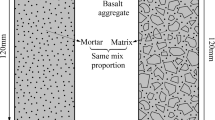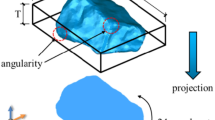Abstract
A declined table test is proposed to determine the fresh properties of mortar and concrete. Different from the conventional slump test that is conducted on the flat table, a flow angle of fresh mortar or concrete will appear through the slump test on the declined table. This study investigates the relationships between the fresh properties tested by the conventional slump test and the flow angles on the declined table, with reference to the visual stability index specified in the ASTM C1611 and density distribution method based on the conventional slump test, the feasibility of the declined table method to evaluate the dynamic segregation of fresh concrete is verified. The results indicate that the mortar and concrete with higher fluidity have larger flow angles on the declined table, but the mortar with an unstable state shows an increased trend in the flow angle. The concrete generally has a lower flow angle than the affinal mortar. The ratio of the flow angle of mortar (Am) to the flow angle of concrete (Ac) is feasible to evaluate the dynamic segregation extent of fresh concrete, and a higher Am/Ac value means a severer dynamic segregation tendency. Using a reasonable classification of Am/Ac, the declined table test is feasible to determine whether the fresh concrete is stable or not.









Similar content being viewed by others
References
Koura BO, Hosseinpoor M, Yahia A (2020) Coupled effect of fine mortar and granular skeleton characteristics on dynamic stability of self-consolidating concrete as a diphasic material. Constr Build Mater 263:120131
Yan W, Cui W, Qi L (2020) Effect of aggregate gradation and mortar rheology on static segregation of self-compacting concrete. Constr Build Mater 259:119816
Bilgil A, Ozturk B, Bilgil H (2005) A numerical approach to determine viscosity-dependent segregation in fresh concrete. Appl Math Comput 162(1):225–241
Turgut P, Turk K, Bakirci H (2012) Segregation control of SCC with a modified L-box apparatus. Mag Concr Res 64:707–716
Gao X, Zhang J, Su Y (2019) Influence of vibration-induced segregation on mechanical property and chloride ion permeability of concrete with variable rheological performance. Constr Build Mater 194:32–41
Tenza-Abril AJ, Benavente D, Pla C, Baeza-Brotons F, Valdes-Abellan J, Solak AM (2020) Statistical and experimental study for determining the influence of the segregation phenomenon on physical and mechanical properties of lightweight concrete. Constr Build Mater 238:117642
Solak AM, Tenza-Abril AJ, García-Vera VE (2022) Adopting an image analysis method to study the influence of segregation on the compressive strength of lightweight aggregate concretes. Constr Build Mater 323:126594
Howes R, Hadi MNS, South W (2019) Concrete strength reduction due to over compaction. Constr Build Mater 197:725–733
ASTM C 1610 (2014) Standard test method for static segregation of self-consolidating concrete using column technique. ASTM International
EFNARC (2005) Self-compacting concrete, European Project Group, The European guidelines for self-compacting concrete: specification, production and use
Bui VK, Montgomery D, Hinczak I, Turner K (2002) Rapid testing method for segregation resistance of self-compacting concrete. Cem Concr Res 32:1489–1496
Mouret M, Escadeillas G, Bascoul A (2008) Metrological significance of the column test in the assessment of the static segregation of self-compacting concrete concrete in the fresh state. Mater Struct 41:663–679
AASHTO R 81 (2017) Standard practice for static segregation of hardened self-consolidating concrete (SCC) cylinders
Navarrete I, Lopez M (2016) Estimating the segregation of concrete based on mixture design and vibratory energy. Constr Build Mater 122:384–390
Cui W, Miao R, Yan W, Song H, Jiang Z (2022) Static segregation of fresh high workable concrete based on an image processing method. Constr Build Mater 361:129708
Han J, Yan P (2021) Influence of segregation on the permeability of self-consolidating concrete. Constr Build Mater 269:121277
Abdelouahab G, Abdelhalim B, Laefer DF (2019) Characterising the segregation of self-consolidating concrete using ultrasonic pulse velocity. J S Afr Inst Civ Eng 61(1):26–37
ASTM C 1712 (2014) Standard test method for rapid assessment of static segregation resistance of self-consolidating concrete using penetration test. ASTM International
Yim HJ, Bae YH, Kim JH (2020) Method for evaluating segregation in self-consolidating concrete using electrical resistivity measurements. Constr Build Mater 232:117283
Pan J, He J, Zhu J, Gao X (2022) Theoretical and experimental study on the electrical resistivity method for evaluating fresh concrete segregation. J Build Eng 48:103943
Nili M, Razmara M, Nili M, Razmara P (2017) Proposing new methods to appraise segregation resistance of self-consolidating concrete based on electrical resistivity. Constr Build Mater 146:192–198
Shen L, Struble L, Lange D (2007) New method for measuring static segregation of self-consolidating concrete. J Testing Eval 35(3):303–309
Shen L, Jovein HB, Li M (2014) Measuring static stability and robustness of self-consolidating concrete using modified Segregation Probe. Constr Build Mater 70:210–216
ASTM C 1611 (2014) Standard test method for slump flow of self-consolidating concrete. ASTM International
Shen L, Jovein HB, Wang Q (2016) Correlating aggregate properties and concrete rheology to dynamic segregation of self-consolidating concrete. J Mater Civ Eng 28(1):04015067
Shen L, Jovein HB, Sun Z, Wang Q, Li W (2015) Testing dynamic segregation of self-consolidating concrete. Constr Build Mater 75:465–471
Esmaeilkhanian B, Feys D, Khayat KH, Yahia A (2014) New test method to evaluate dynamic stability of self-consolidating concrete. ACI Mater J 111:299–308
Esmaeilkhanian B, Khayat KH, Yahia A, Feys D (2014) Effects of mix design parameters and rheological properties on dynamic stability of self-consolidating concrete. Cem Concr Compos 54:21–28
Gökçe HS, Andiç-Çakır Ö (2018) A new method for determination of dynamic stability of self-consolidating concrete: 3-compartment sieve test. Constr Build Mater 168:305–312
JGJ55 2011 (2011) Specification for mix proportion design of ordinary concrete, Ministry of Housing and Urban-Rural Development of the People's Republic of China
GB/T 50080-2016 (2016) Standard for test method of performance on ordinary fresh concrete, Ministry of Housing and Urban-Rural Development of the People's Republic of China
Tregger N, Gregori A, Ferrara L, Shah S (2012) Correlating dynamic segregation of self-consolidating concrete to the slump-flow test. Constr Build Mater 28(1):499–505
Gökçe HS, Andiç-Çakır Ö (2020) A dynamic segregation test method for heavyweight concrete: density variation method. J Test Eval 48(5):3331–3340
GB/T 17671-2021 (2021) Test method of cement mortar strength (ISO method). National Cement Standardization Technical Committee
Jimma BE, Rangaraju PR (2014) Film-forming ability of flowable cement pastes and its application in mixture proportioning of pervious concrete. Constr Build Mater 71:273–282
Yang L, Kou S, Song X, Lu M, Wang Q (2021) Analysis of properties of pervious concrete prepared with difference paste-coated recycled aggregate. Constr Build Mater 269:121244
Kwan AKH, Li LG (2014) Combined effects of water film, paste film and mortar film thicknesses on fresh properties of concrete. Constr Build Mater 50:598–608
Lee JH, Kim JH, Yoon JY (2018) Prediction of the yield stress of concrete considering the thickness of excess paste layer. Constr Build Mater 173:411–418
Xu Z, Li Z (2021) Numerical method for predicting flow and segregation behaviors of fresh concrete. Cem Concr Compos 123:104150
Kim JH, Yim HJ, Kwon SH (2014) Quantitative measurement of the external and internal bleeding of conventional concrete and SCC. Cem Concr Compos 54:34–39
Gökçe HS, Andiç-Çakır Ö (2019) Bleeding characteristics of high consistency heavyweight concrete mixtures. Constr Build Mater 194:153–160
Acknowledgements
This work was supported by Natural Science Foundation of Henan Province, Key R&D and Promotion Project of Henan Province (222102320362), the Science and Technology Development Project of Henan Province (152102210053) and the Science and Technology Open Cooperation Project of Henan Academy of Sciences in 2021 (210909015).
Author information
Authors and Affiliations
Corresponding author
Ethics declarations
Conflict of interest
The authors declare that they have no known competing financial interests or personal relationships that could have appeared to influence the work reported in this paper.
Additional information
Publisher's Note
Springer Nature remains neutral with regard to jurisdictional claims in published maps and institutional affiliations.
Rights and permissions
Springer Nature or its licensor (e.g. a society or other partner) holds exclusive rights to this article under a publishing agreement with the author(s) or other rightsholder(s); author self-archiving of the accepted manuscript version of this article is solely governed by the terms of such publishing agreement and applicable law.
About this article
Cite this article
Xu, G., Wu, H., Cai, J. et al. Dynamic stability evaluation of fresh concrete with the declined table test. Mater Struct 57, 5 (2024). https://doi.org/10.1617/s11527-023-02273-y
Received:
Accepted:
Published:
DOI: https://doi.org/10.1617/s11527-023-02273-y




